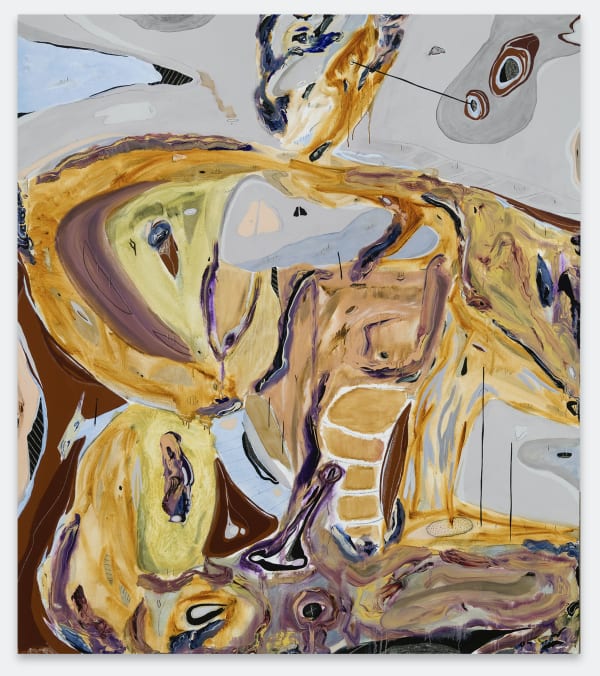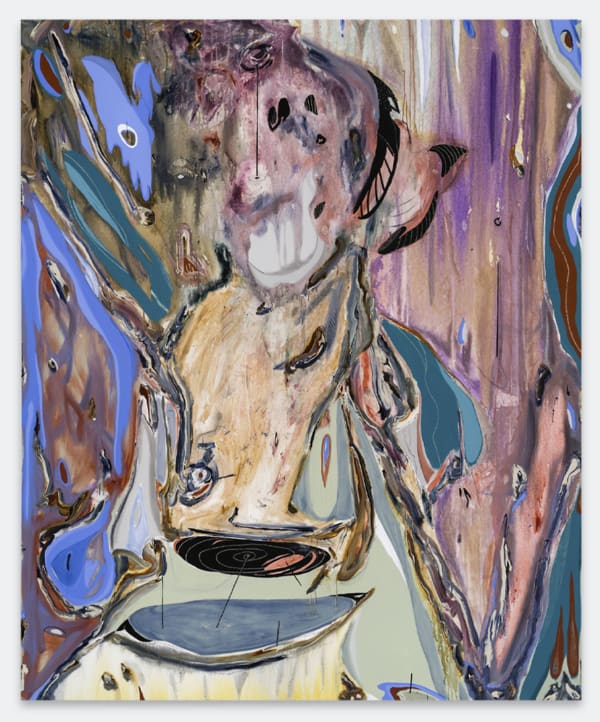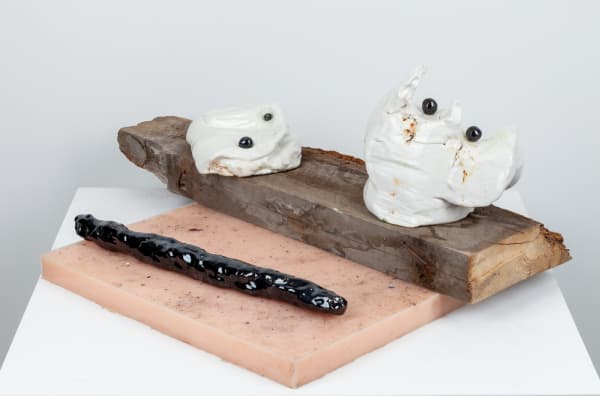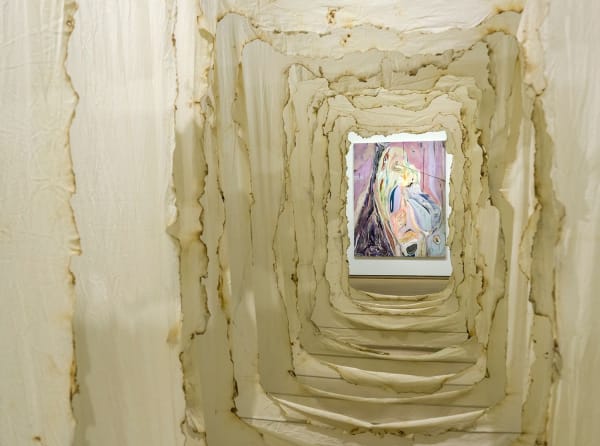Manuel Mathieu, Negroland: A Landscape of Desires: Kavi Gupta | 219 N. Elizabeth St. Chicago, IL 60607
"There is no ground of alternatives but to recover the 'dangerous' chasm, the 'forbidden' ascent and seek a new dimension of feeling – a new oath of humanity.” – Wilson Harris
“What can I specifically bring to the table, that no one else can, spiritually?” was Mathieu’s question after a near-death experience. Taking up this task of singularity or authenticity, that is to say, using your soul for a purpose, relates to Ezili’s principle– the possibility of creating beyond need, perceiving beyond reality, and desiring beyond mere survival. Meatspace takes on a texture of virtuality here at the nexus where mythic objective reality and subjectively-felt narrative reality mesh. There can be no use for Christian dualisms here: between figuration and abstraction; modular soul and open, networked vessel; flesh and spirit. Mathieu’s forms, whether in painting or more recently in ceramics and sculpture, straddle these socially constructed dualisms as a matter of course, tracing lines of flight toward a formal language commensurate to the task of the singular. He is always depicting something, but what’s depicted is less an object and more a net of interrelations registered in a certain rhythm of forms. He goes further, arguing (in personal correspondence) that this is trivially true–such a net is the only thing that can ever be depicted in an inherently mediated reality like ours where “actual figuration is a conceptual impossibility.” This site of impossibility is the work’s starting point–“I start painting when what I’m trying to achieve is impossible.”
Something in a Dream
Take me to where sun screams for moon’s returning embrace– its fiery rage no solace for the burn of loneliness– no still center, only the mostly-empty space of which thoughts and objects consist, careening like the sun on path unseen, the void of symmetry. And yet nothing can fit in all that void but a gaze whose source we suspect is alien. The call is coming from inside the house. The death and rebirth cycle of a million worshiped suns– what does this have to do with loneliness, with the sacred bonded pair of sun and moon?
The more human I become, the less I understand. They tell me don’t trouble blood, that dimly gowned time spoke dimly, with ache. I ritually neglect my dreams, and yet this ache is more than dream: you were thrown into the world like a gesture, meant to decay into nothing. The pentecost of linearity. Forgetting things happens in the image of God (tzelem elohim). Imagine the Afro-Portuguese colonial fur trapper and merchant from Spaniard-colonized Haiti, Jan Rodriges, falls asleep in 1624 and wakes up in 1970, in the Bronx, to a scene of slumlords burning tenements for insurance.
For so long he went around saying I’m from the first city in the New World, I’m the first non-Indian on Mannahatta and Rananchqua, my fur game is crazy. Now, in the post-apocalyptic context of the late 20th century Bronx, his skills proved useless. He rode iron snakes sizzling with colored symbols on their surface, struggling from one weird low-paid task to the next, always covered in a thin film of hatred, hoping for time to himself to come to grips with it all and think about his lost family. He works with a local spiritist to eventually learn his own soul has transmigrated from a Moorish woman from Al-Andalus, who died by her own hand in a wadi (valley). He could never look her in the face.
Sound is not the wife of meaning. Time began with a Word, but time is neither grace nor suffering. I found your photo in a notebook. I remember I wouldn’t go into the water with you. Images don’t come to me anymore. This isn’t exactly your kind of place. Sound is the depth of the unthought, the beginning of Time. The moon grew so big it touched the surface of the language, its glow resonant at the interfaces as it broke. Stand naked before mystery, working on the other side of time. God assigns us each a monster to care for. The last time we spoke, I saw two versions of a stone castle trapped in a falling tooth. An informatic universe is a sexy universe, which got you stuck off the realness.
— manuel arturo abreu
Manuel Mathieu has been thinking about the messiness of desire. In Negroland: A Landscape of Desires, his second solo exhibition with Kavi Gupta, Mathieu debuts a new body of metaphysical paintings and sculptures grounded in what the artist calls “the dream that our desires can be perceived as more than transactional.”
He is speaking of physical, sexual, and sensual desire, of course. The exhibition’s show card features a collaged image of the eyes of Jennifer Jackson, the first Black Playmate of the Month in Playboy Magazine. She was featured in the March 1965 issue, ironically during the civil rights movement.
In ten new paintings created for the show, soil, flesh, and sky become a singular, ever-evolving mass. Forms, figures, and colors swirl in sensual, primordial pools, as if melted together and poured onto the canvas.
Ceramics came into Mathieu’s research as an element that triggers a sense of alchemy, turning the four elements into an object that carries a spiritual value. For Mathieu, this sense of awareness that the object can echo itself in several dimensions though our humanity and spirituality is at the core of the Black experience.
“In the slave ship when our destiny was shattered by disruptors and we were deprived of everything we owned and turned into objects, holding onto a rock during the crossing and turning that rock, just like the Igbo did before us, through our prayers into a symbol of our hopes and desires was pivotal to preserve what was most precious in us, our humanity,” says Mathieu. “This exercise mimics our capacities as a Black people against all odds to transcend our experiences and turn dust into mountains.”
The installation All spells came from that idea of transforming simple elements and embedding them with a form of sensibility—a spiritual value that transcends our cognitive understanding of reality.
The ceramic sculptures are approached as conceptual subjects referencing the body in transformation, constantly returning to its core—Where should we begin. The artist understands these sculptures as existing 50 feet high outside of the gallery.
In a recent essay, Dominican artist, poet, and art critic Manuel Arturo Abreu compares Mathieu’s ongoing material investigation into flesh and spirit to the principles espoused by the Vodou spirit force Ezili. Abreu writes:
“'What can I specifically bring to the table, that no-one else can, spiritually?' was Mathieu’s question after experiencing a near death experience. Taking up this task of singularity or authenticity, that is to say, using your soul for a purpose, relates to Ezili’s principle—the possibility of creating beyond need, perceiving beyond reality, and desiring beyond mere survival. Mathieu’s forms, whether in painting or more recently in ceramics and sculpture, straddle these socially constructed dualisms as a matter of course... He is always depicting something, but what’s depicted is less an object and more a net of interrelations registered in a certain rhythm of forms.”
Mathieu says that during the past year working in isolation he came to see his studio as a sort of crucible—a container in which internal and external forces were creating the circumstances for transformation.
“The artist is also a crucible,” Mathieu says. “Even as the inner forces are changing things, the crucible itself is also being altered. Things are merging inside of me and also changing me. What are those forces? With this body of work, I tried to get back to that sense of urgency that pushed me to become an artist and stay in the process with what is necessary.”
Haiti-born, Montreal-based Manuel Mathieu (b. 1986) is a multidisciplinary artist known for work that investigates themes of historical violence, erasure, religious symbolism, nature, and the various futures made possible by the act of remembering. He earned his MFA from Goldsmiths, University of London, in 2016. Recent solo exhibitions include World Discovered Under Other Skies, The Power Plant, Toronto (2020), Survivance, Montreal Museum of Fine Arts, Montreal (2020), andManuel Mathieu:Nobody Is Watching, Kavi Gupta, Chicago (2018).
-
 Manuel MathieuSpiritual Trial, 2021Acrylic, oil stick, chalk, charcoal, and tape on canvas96 x 84 x 1 1/2 in
Manuel MathieuSpiritual Trial, 2021Acrylic, oil stick, chalk, charcoal, and tape on canvas96 x 84 x 1 1/2 in
243.8 x 213.4 x 3.8 cm -
 Manuel MathieuThe Prophetess 2, 2020Acrylic, chalk, charcoal, and tape on canvas110 x 90 x 1 1/2 in
Manuel MathieuThe Prophetess 2, 2020Acrylic, chalk, charcoal, and tape on canvas110 x 90 x 1 1/2 in
279.4 x 228.6 x 5.1 cm -
 Manuel MathieuTo be whole/The Encounter, 2021Acrylic, oil stick, chalk, charcoal, and tape on canvas75 x 80 x 2 in
Manuel MathieuTo be whole/The Encounter, 2021Acrylic, oil stick, chalk, charcoal, and tape on canvas75 x 80 x 2 in
190.5 x 203.2 x 5.1 cm -
 Manuel MathieuResilience - A Landscape of Desire, 2020Fabric, ink, and soil80 x 110 x 3 in
Manuel MathieuResilience - A Landscape of Desire, 2020Fabric, ink, and soil80 x 110 x 3 in
203.2 x 279.4 x 7.6 cm -
 Manuel MathieuSomatic, 2020Charcoal, Chalk, pastel, Gesso on paperUnframed: 68 x 59 in
Manuel MathieuSomatic, 2020Charcoal, Chalk, pastel, Gesso on paperUnframed: 68 x 59 in
Framed: 72.5 x 64.5 in
Unframed: 173 x 152 cm
Framed: 184 x 164cm -
 Manuel MathieuWhere Should We Begin, 2021Ceramic8 x 8 x 3 in
Manuel MathieuWhere Should We Begin, 2021Ceramic8 x 8 x 3 in
20.3 x 20.3 x 7.6 cm -
 Manuel MathieuThe Loss of Innocence, 2021Ceramic16 x 2 x 1 1/2 in
Manuel MathieuThe Loss of Innocence, 2021Ceramic16 x 2 x 1 1/2 in
40.6 x 5.1 x 3.8 cm -
 Manuel MathieuWet Mammy, 2021Ceramic, silicone, and mixed media14 x 24 x 21 in
Manuel MathieuWet Mammy, 2021Ceramic, silicone, and mixed media14 x 24 x 21 in
35.6 x 61 x 53.3 cm -
 Manuel MathieuWhite Gaze, 2021Ceramic, wood, and silicone33 x 24 x 13 1/2 in
Manuel MathieuWhite Gaze, 2021Ceramic, wood, and silicone33 x 24 x 13 1/2 in
83.8 x 61 x 34.3 cm -
 Manuel MathieuHead, 2021Acrylic, oil stick, chalk, charcoal, and tape on canvas24 x 24 x 2 in
Manuel MathieuHead, 2021Acrylic, oil stick, chalk, charcoal, and tape on canvas24 x 24 x 2 in
61 x 61 x 5.1 cm -
 Manuel MathieuBlack Joy, 2021Acrylic, oil stick, chalk, charcoal, and tape on canvas44 x 20 x 2 in
Manuel MathieuBlack Joy, 2021Acrylic, oil stick, chalk, charcoal, and tape on canvas44 x 20 x 2 in
111.8 x 50.8 x 5.1 cm -
 Manuel MathieuBlack Dwarf, 2021Acrylic, oil stick, chalk, charcoal, and tape on canvas20 x 24 x 2 in
Manuel MathieuBlack Dwarf, 2021Acrylic, oil stick, chalk, charcoal, and tape on canvas20 x 24 x 2 in
50.8 x 61 x 5.1 cm -
 Manuel MathieuA Natural Sense of Self, 2021Acrylic, oil stick, chalk, charcoal, silicone, and tape on canvas26 1/2 x 30 x 2 in
Manuel MathieuA Natural Sense of Self, 2021Acrylic, oil stick, chalk, charcoal, silicone, and tape on canvas26 1/2 x 30 x 2 in
67.3 x 76.2 x 5.1 cm -
 Manuel MathieuAll Spells, 2021Ceramic132 x 216 in
Manuel MathieuAll Spells, 2021Ceramic132 x 216 in
335.3 x 548.6 cm -
 Manuel MathieuCurl it if you can, 2020Watercolor, Pen, Pencil, Charcoal on paperUnframed: 11 x 11.875 in
Manuel MathieuCurl it if you can, 2020Watercolor, Pen, Pencil, Charcoal on paperUnframed: 11 x 11.875 in
Framed: 14 x 16 in
Unframed: 28 x 30 cm
Framed: 38 x 41 cm -
 Manuel MathieuFound Images, 2021Acrylic, oil stick, chalk, charcoal, and tape on paper20 x 26 x 2 in
Manuel MathieuFound Images, 2021Acrylic, oil stick, chalk, charcoal, and tape on paper20 x 26 x 2 in
50.8 x 66 x 5.1 cm -
 Manuel MathieuLittle Girl, 2021Black and white polaroid4 x 5 in
Manuel MathieuLittle Girl, 2021Black and white polaroid4 x 5 in
10.2 x 12.7 cm









































